
What is UI/UX? A Complete Guide 2025
Feb 28, 2025 9 Min Read 11594 Views
(Last Updated)
In today’s digital world, every app, website, or software you use is designed to give you the best experience possible. Have you ever wondered why some apps feel intuitive and easy to use while others feel frustrating? That’s where UI (User Interface) and UX (User Experience) design come into play.
The terms UI (User Interface) and UX (User Experience) have become pivotal components in the design and development process. These two concepts are often used interchangeably, yet they represent distinct aspects of user interaction with digital products.
If you’re looking to understand what UI/UX is, how they differ, and why they matter, you’re in the right place. In this article, you’ll learn everything you need to know about UI and UX design, their key components, skills, processes, roles, responsibilities, career prospects, and much more.
Table of contents
- What is UI/UX?
- What is UI?
- Key Components of UI Design
- UI Design Tools
- What is UX (User Experience)?
- Key Components of UX Design
- UX Design Tools
- UI/UX Design Process – Step-by-Step
- UI vs. UX
- Must-Have UI/UX Skills
- Top UI/UX Roles, Responsibilities, and Salaries
- UX Designer
- UI Designer
- UX Researcher
- Product Designer
- Interaction Designer
- UI/UX Developer
- Takeaways…
- FAQs
- Q1. What is meant by UI and UX?
- Q2. Does UI UX require coding?
- Q3. Where is UI UX used?
- Q4. Does UI UX have a scope?
What is UI/UX?
To understand UI/UX, we must first understand these aspects separately. Hence, for your better understanding, we will first discuss what UI and UX are, so that you can understand what UI/UX is and does as a whole.
What is UI?
User Interface (UI) design is the process of designing visually appealing, functional, and interactive digital interfaces that allow users to engage with a product seamlessly. It focuses on crafting the look and feel of websites, mobile apps, and other digital platforms, ensuring they are aesthetically pleasing and easy to use. A well-designed UI enhances user engagement, accessibility, and efficiency, making digital experiences intuitive and enjoyable.
Key Components of UI Design
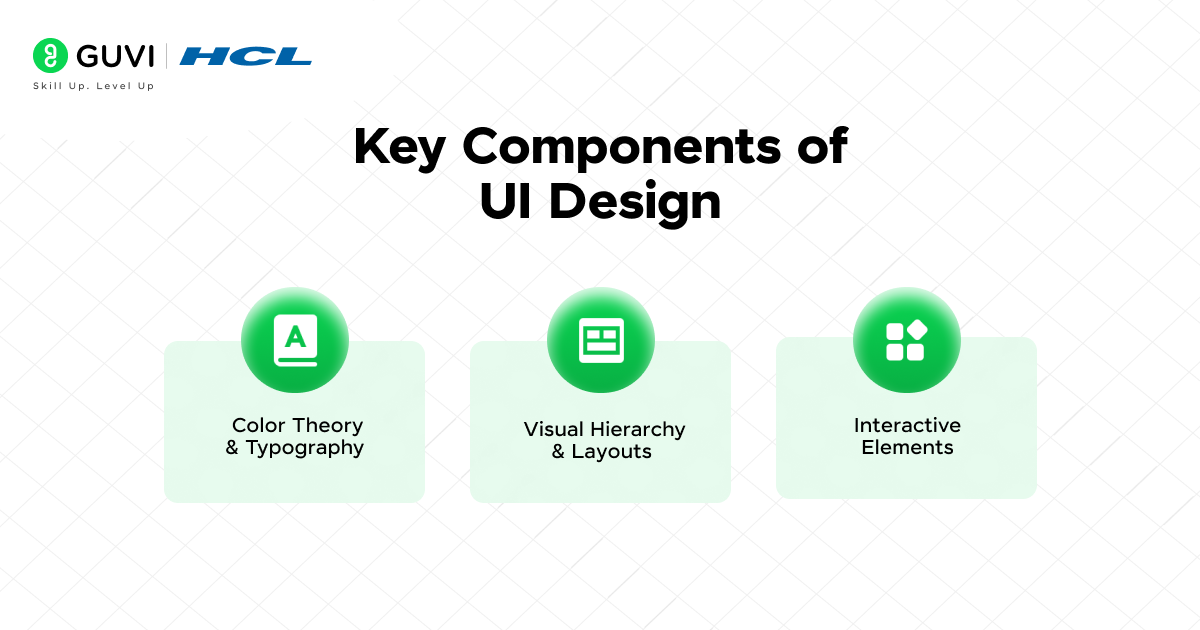
1) Color Theory & Typography
Color and typography are fundamental to UI design, shaping the visual identity and user perception of a product. Color psychology plays a significant role in influencing user emotions and behaviors. For example, blue conveys trust and professionalism, while red signifies urgency and excitement. Proper color contrast ensures readability and accessibility.
Typography, on the other hand, impacts readability, hierarchy, and engagement. Fonts must be legible on different screens, with appropriate spacing and alignment. Designers often use a primary font for headings and a secondary font for body text, maintaining consistency throughout the interface.
2) Visual Hierarchy & Layouts
A strong visual hierarchy ensures that users focus on the most important elements first. Designers use size, contrast, and spacing to guide attention toward key actions and information. Grid-based layouts organize content effectively, allowing for smooth navigation and reducing clutter.
3) Interactive Elements
Buttons, icons, and animations play a crucial role in making a UI interactive and intuitive.
- Buttons: These serve as calls to action (CTA), helping users complete tasks efficiently. They should be well-placed, clearly labeled, and visually distinct.
- Icons: Represent functions or features in a compact form, aiding in quick recognition and navigation.
- Animations: Subtle transitions and micro-interactions enhance the user experience by providing feedback and smooth transitions between actions.
UI Design Tools
To create high-quality interfaces, UI designers rely on specialized tools for design, prototyping, and collaboration. Some of the most popular UI design tools include:
- Figma: A cloud-based design tool that supports real-time collaboration, making it ideal for teams.
- Adobe XD: Offers robust design and prototyping capabilities, with seamless integration into the Adobe ecosystem.
- Sketch: A vector-based UI design tool widely used for creating high-fidelity interfaces.
- InVision: Primarily used for prototyping and user testing, allowing designers to create interactive mockups.
- Framer: A tool that bridges UI design and front-end development, offering advanced animations and code integration.
These tools enable UI designers to craft visually compelling and user-friendly interfaces while streamlining collaboration with UX designers and developers.
What is UX (User Experience)?
Now that we’ve understood what UI is and does, let’s move onto UX. UX (User Experience) design is the process of enhancing a user’s interaction with a product by focusing on functionality, accessibility, and overall satisfaction.
It involves understanding user needs, behaviors, and expectations to create seamless and meaningful experiences. A well-designed UX ensures that users can navigate and interact with digital products effortlessly, leading to higher engagement and retention.
Unlike UI, which deals with the visual aesthetics of an interface, UX focuses on the entire journey of a user, from discovery to interaction and beyond. It is a problem-solving approach that aims to remove pain points and create intuitive, user-friendly digital products. Whether it’s a website, mobile app, or software, UX design ensures that the product meets the user’s needs efficiently and enjoyably.
Key Components of UX Design
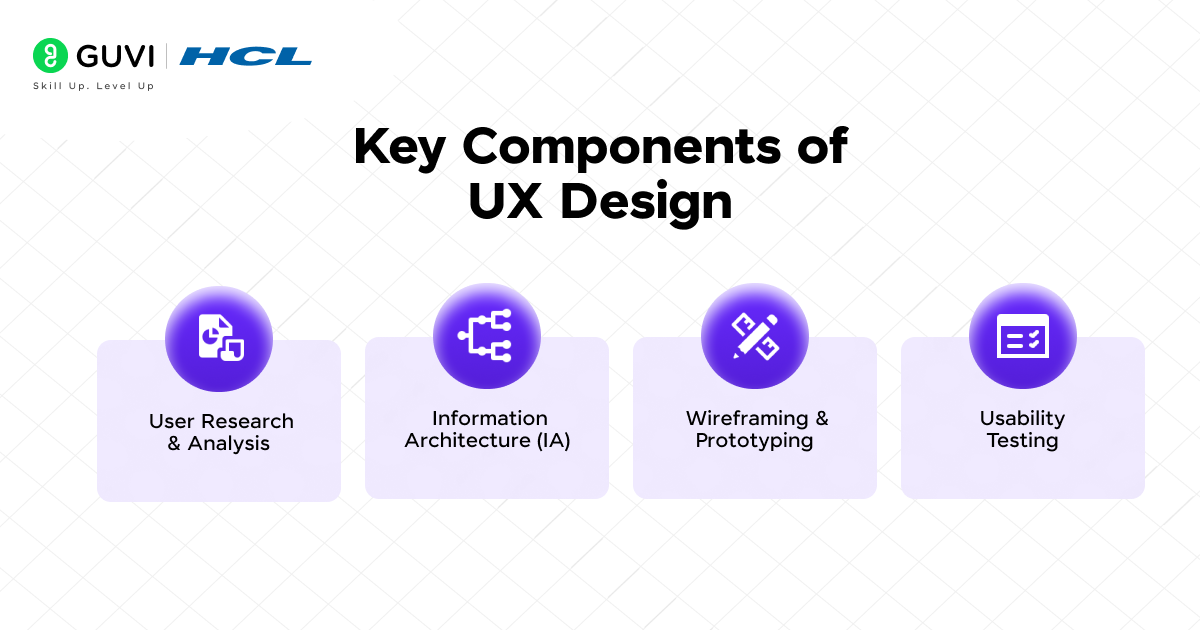
1) User Research & Analysis
User research is the foundation of UX design. It involves gathering insights about users through surveys, interviews, and data analysis. By understanding user demographics, behaviors, and pain points, you can create a product that aligns with their expectations. Effective UX research helps in identifying the problems users face and provides solutions tailored to their needs.
2) Information Architecture (IA)
Information Architecture refers to the organization and structuring of content within a product to ensure easy navigation. A well-planned IA ensures that users can find the information they need quickly and effortlessly. It involves designing site maps, categorizing content logically, and establishing a smooth flow that guides users through the platform without confusion.
3) Wireframing & Prototyping
Wireframing is the process of creating low-fidelity sketches or blueprints of a product’s layout before finalizing the UI. It helps visualize the structure, flow, and functionality without being distracted by colors and graphics. Prototyping takes it a step further by building interactive models that simulate real interactions. This allows designers to test usability, refine designs, and identify improvements before actual development.
4) Usability Testing
Usability testing is essential to evaluate how real users interact with a product and whether it meets their expectations. It involves conducting tests like A/B testing, heatmaps, and user feedback sessions to identify usability issues. By analyzing user behavior, UX designers can make data-driven improvements, ensuring the final product is intuitive and user-friendly.
UX Design Tools
A variety of UX design tools assist in different stages of the design process, from research and wireframing to prototyping and usability testing. Below are some of the most widely used tools in the industry:
- Adobe XD – A powerful vector-based tool for designing, prototyping, and collaborating on UI/UX designs. It supports real-time collaboration, interactive prototyping, and integrations with other Adobe products, making it a favorite among designers for high-fidelity mockups.
- Axure – Known for its advanced prototyping capabilities, Axure allows designers to create highly interactive wireframes with dynamic elements and conditional logic. This makes it an excellent choice for testing complex user interactions before moving to development.
- Balsamiq – A low-fidelity wireframing tool designed for quick sketches of user interfaces. Its simple, hand-drawn style helps teams focus on functionality rather than aesthetics, making it ideal for brainstorming and early-stage design discussions.
- Maze – A usability testing platform that enables designers to gather real-time user insights through click tests, A/B testing, and heatmaps. It helps in validating design decisions by allowing users to interact with prototypes and provide feedback without coding.
- UsabilityHub – A remote user research tool that helps designers conduct preference tests, five-second tests, and click tests to understand user behavior. It provides valuable insights into how users perceive and interact with different UI elements, allowing for data-driven improvements.
Each of these tools serves a specific purpose in the UX design workflow, ensuring that products are intuitive, user-friendly, and optimized for a seamless user experience. By leveraging the right tools, you can create designs that not only look great but also function effectively for users.
UI/UX Design Process – Step-by-Step
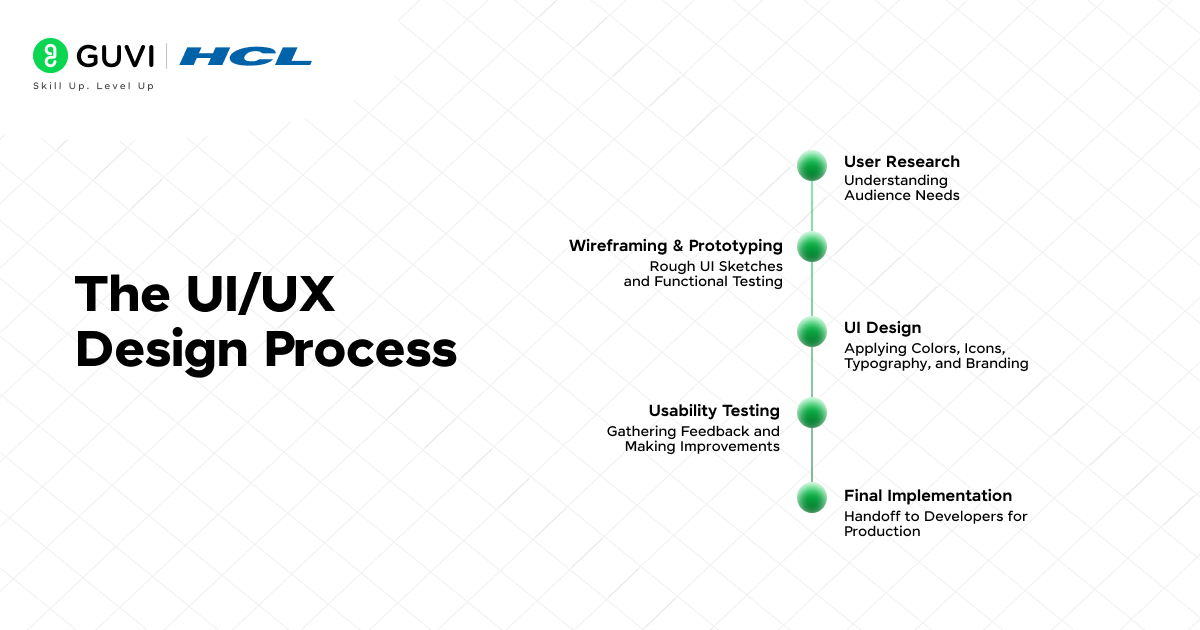
In order to understand UI/UX better together, we must understand the UI/UX process and how this creative magic happens, let’s begin.
The UI/UX design process is a structured approach to creating user-centric digital products that are both visually appealing and highly functional. It involves understanding user needs, designing intuitive interfaces, testing usability, and refining the experience through continuous improvements. A well-executed UI/UX process ensures seamless interactions, enhances engagement, and drives business success.
1) User Research – Understanding Audience Needs
Before designing any product, you must first understand your target users. This involves conducting surveys, interviews, and analyzing user behavior to identify their pain points and expectations. Research methods like persona creation, empathy mapping, and user journey mapping help you gain deeper insights into user goals and frustrations.
By gathering this information, you can make data-driven design decisions that improve usability and engagement. You should also study competitors’ products to identify gaps and opportunities. A well-researched UI/UX strategy ensures that the final product aligns with user needs and business objectives.
2) Wireframing & Prototyping – Rough UI Sketches and Functional Testing
Once user research is complete, the next step is wireframing and prototyping. Wireframing involves creating low-fidelity sketches of your interface layout, ensuring that content placement, navigation flow, and user interactions are logically structured. Tools like Figma, Adobe XD, and Sketch help you create digital wireframes for better visualization.
Prototyping takes wireframes a step further by making them interactive. This allows you to test the functionality and user journey before finalizing the design. Prototypes help stakeholders visualize the product experience and enable designers to refine workflows based on early feedback.
3) UI Design – Applying Colors, Icons, Typography, and Branding
UI design focuses on the aesthetics and visual elements of the interface. At this stage, you apply a consistent color scheme, typography, button styles, and branding elements that align with the product’s identity. A good UI design enhances user engagement while maintaining clarity and accessibility.
You also need to consider visual hierarchy, contrast, and whitespace to guide user attention effectively. Interactive components like hover effects, animations, and micro-interactions further enhance the experience, making navigation seamless and intuitive.
4) Usability Testing – Gathering Feedback and Making Improvements
Usability testing helps validate the design by analyzing real user interactions. You should conduct A/B testing, heatmaps, and user testing sessions to gather qualitative and quantitative feedback. These insights help identify usability issues such as confusing navigation, slow load times, or unclear CTAs (Call-to-Actions).
Iterative testing ensures that the design meets user expectations and enhances overall functionality. By continuously refining the interface based on feedback, you create a product that offers a seamless and efficient user experience.
5) Final Implementation – Handoff to Developers for Production
Once the UI/UX design is finalized, the next step is development. Designers collaborate with developers to ensure smooth implementation, providing design specifications, style guides, and interactive prototypes. Tools like Zeplin and Figma facilitate this handoff by exporting design assets with accurate dimensions and CSS properties.
During the development phase, it’s crucial to conduct final design quality assurance (QA) checks. This ensures that the implemented UI matches the original design vision, maintaining responsiveness, accessibility, and cross-platform compatibility. A well-executed UI/UX design leads to a product that is both visually appealing and highly functional.
UI vs. UX
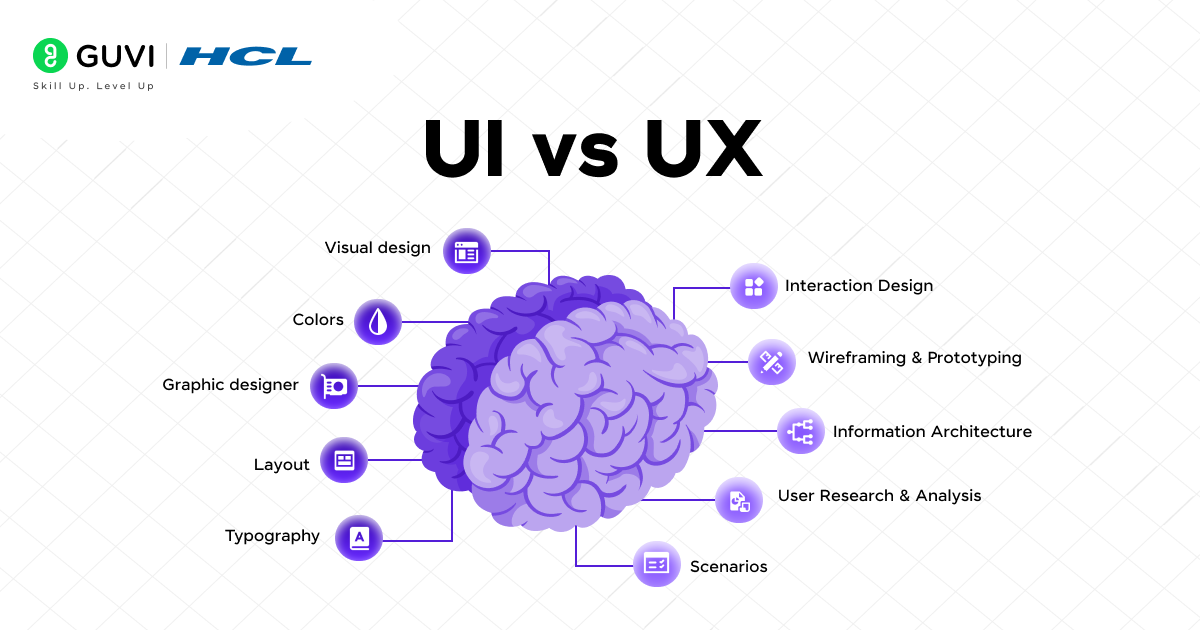
After learning about the UI/UX process, I’m sure you’ve completely understood what UI/UX is and what it does. So now to gain a holistic overview about UI/UX, we must go through how they differ. And this table will help you understand their differences with ease and in no time:
| Aspect | UI | UX |
| Definition | Focuses on the look, feel, and interactivity of a product. | Focuses on the overall user journey and experience while interacting with a product. |
| Goal | Enhances visual appeal and usability. | Improves user satisfaction and ensures a smooth, seamless experience. |
| Focus Areas | Typography, colors, layouts, buttons, animations, icons. | User research, usability, wireframing, user testing, interaction design. |
| Key Deliverables | High-fidelity UI designs, design systems, prototypes. | Wireframes, user flows, journey maps, personas, usability reports. |
| Main Responsibilities | Designing aesthetically pleasing interfaces, ensuring consistency, and implementing branding. | Researching user behavior, improving user engagement, and optimizing usability. |
| Tools Used | Figma, Adobe XD, Sketch, Framer, Illustrator. | Figma, Miro, Axure, Hotjar, Google Analytics. |
| Who Works on It? | UI Designers, Visual Designers, Front-End Developers. | UX Designers, UX Researchers, Product Designers. |
| Importance | Ensures a product is visually appealing and easy to navigate. | Ensures a product is functional, enjoyable, and meets user needs. |
| Example | Choosing the right colors, buttons, and layouts for a mobile app. | Ensuring the user can complete a purchase easily without confusion. |
Must-Have UI/UX Skills
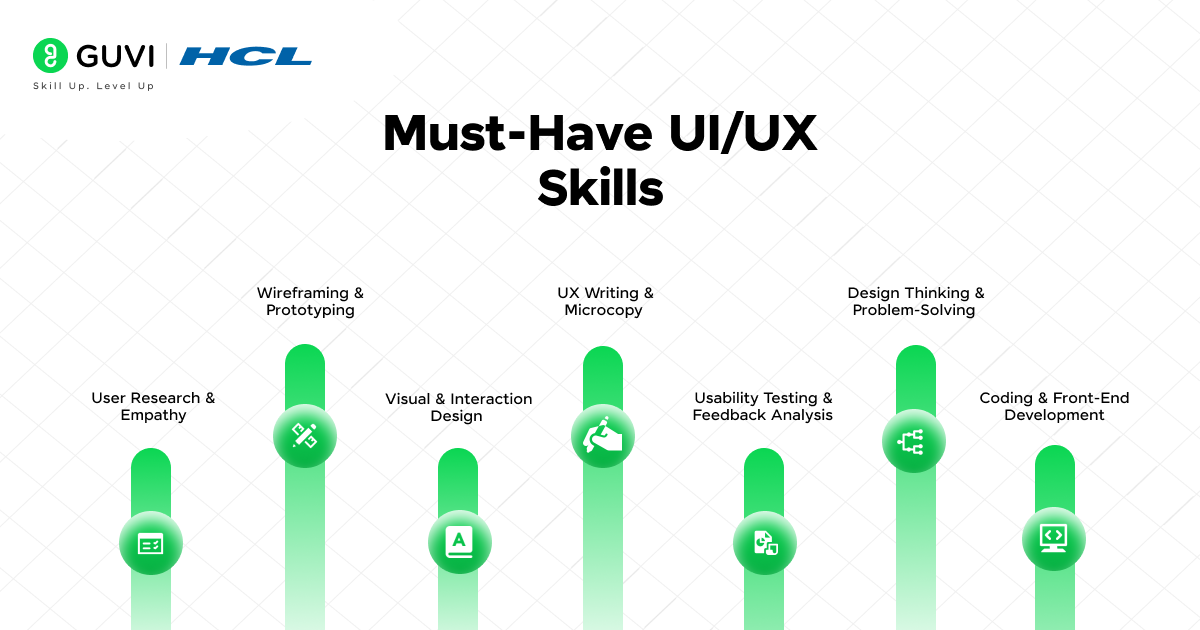
To become a successful UI/UX designer, you need a combination of technical, creative, and analytical skills. These skills help you craft intuitive interfaces, optimize user experiences, and ensure seamless interactions. Below are the essential UI/UX skills you should master:
1) User Research & Empathy
Understanding your users is the foundation of great UI/UX design. You must be able to conduct interviews, surveys, and usability testing to gather insights into user behavior and pain points. Empathy plays a crucial role in this process, as it allows you to step into the user’s shoes and design solutions that truly meet their needs.
By analyzing user data and feedback, you can create personas and journey maps to tailor experiences. Strong user research skills help you make data-driven decisions that enhance usability and user satisfaction.
2) Wireframing & Prototyping
Wireframing and prototyping are essential for planning UI layouts and testing interactions before full-scale development. Wireframes serve as blueprints for your interface, outlining structure, navigation, and content placement.
Prototyping takes wireframes a step further by making them interactive. Tools like Figma, Adobe XD, and Sketch allow you to build clickable prototypes for usability testing. Mastering these tools helps you iterate faster, validate design concepts, and ensure smooth user flows.
3) Visual & Interaction Design
A strong UI designer needs expertise in color theory, typography, spacing, and composition. You should know how to create visually appealing designs that maintain clarity and consistency across different screens and devices.
Additionally, interaction design plays a key role in making interfaces engaging. Micro-interactions, animations, and transitions enhance user engagement by providing feedback and guiding attention. A well-designed UI ensures that users can navigate intuitively without confusion.
4) UX Writing & Microcopy
Clear and concise microcopy improves usability by guiding users through an interface. Error messages, button labels, tooltips, and onboarding instructions should be intuitive and action-driven.
You should develop strong UX writing skills to create engaging and user-friendly content. Effective microcopy helps reduce cognitive load, ensuring users understand what to do without frustration.
5) Usability Testing & Feedback Analysis
Testing your designs with real users helps uncover usability issues before final implementation. You should be proficient in conducting A/B tests, heuristic evaluations, and heatmap analysis to identify friction points in the user journey.
By collecting feedback and analyzing user interactions, you can refine your designs for better accessibility and functionality. Iterative testing ensures that your UI/UX solutions are not just visually pleasing but also highly efficient.
6) Design Thinking & Problem-Solving
As a UI/UX designer, you must think critically and solve complex user experience challenges. Design thinking helps you adopt a user-first approach, breaking problems down into smaller steps and ideating solutions based on research and testing.
You should practice divergent and convergent thinking to explore multiple design possibilities before finalizing the best solution. Problem-solving skills help you address accessibility issues, optimize workflows, and create designs that enhance user satisfaction.
7) Coding & Front-End Development (Optional but Beneficial)
While not mandatory, having basic knowledge of HTML, CSS, and JavaScript can greatly improve your UI/UX skills. Understanding front-end technologies helps you collaborate better with developers and create more feasible designs.
Knowing how code works allows you to design with development constraints in mind, ensuring that your layouts and interactions translate seamlessly into real-world applications. This skill also enables you to tweak UI components without relying entirely on developers.
If you’re serious about becoming a UI/UX expert and would like to gain all these UI/UX skills and more, GUVI’s UI/UX Design Course is your perfect launchpad! This industry-focused program equips you with hands-on experience, real-world projects, and expert mentorship to help you land top UI/UX roles.
Top UI/UX Roles, Responsibilities, and Salaries
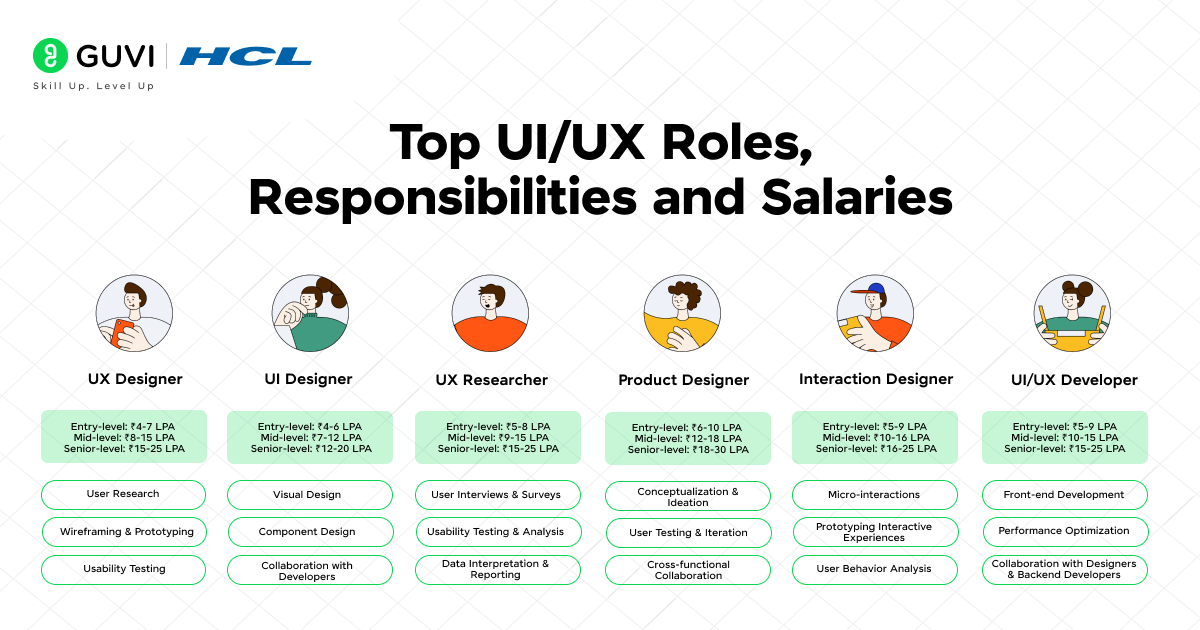
If you’re considering a career in UI/UX design, it’s essential to understand the various roles available, what they entail, and the potential salaries you can earn. The UI/UX field is vast, with different specializations catering to various aspects of user experience and interface design. Here’s a breakdown of the top roles, their responsibilities, and the salaries you can expect.
1. UX Designer
As a UX (User Experience) Designer, your primary focus is on enhancing the overall experience of users when they interact with a product or service. You conduct research, design wireframes, and test prototypes to ensure a seamless and enjoyable user journey. Your role requires empathy, problem-solving skills, and a deep understanding of user behavior.
Responsibilities:
- User Research: You gather insights about user needs, pain points, and behaviors through surveys, interviews, and usability tests.
- Wireframing & Prototyping: You create low-fidelity sketches and high-fidelity interactive prototypes to visualize the user flow and interface structure.
- Usability Testing: You conduct tests to analyze how users interact with your design and refine it based on feedback.
Salary:
Entry-level: ₹4-7 LPA
Mid-level: ₹8-15 LPA
Senior-level: ₹15-25 LPA
2. UI Designer
As a UI (User Interface) Designer, your job revolves around designing visually appealing and interactive interfaces. You focus on typography, color schemes, layouts, and overall aesthetics to ensure users have an intuitive and engaging experience. A strong grasp of design tools and attention to detail are crucial for this role.
Responsibilities:
- Visual Design: You craft stunning interfaces that align with the brand identity and improve user engagement.
- Component Design: You create reusable UI components like buttons, forms, icons, and menus to maintain consistency across designs.
- Collaboration with Developers: You work closely with developers to ensure designs are implemented as intended without compromising usability.
Salary:
Entry-level: ₹4-6 LPA
Mid-level: ₹7-12 LPA
Senior-level: ₹12-20 LPA
3. UX Researcher
As a UX Researcher, your primary role is to understand user behavior and provide data-driven insights to improve designs. You conduct qualitative and quantitative research to ensure products are tailored to users’ needs. This role demands analytical thinking, communication skills, and expertise in research methodologies.
Responsibilities:
- User Interviews & Surveys: You collect data through direct interactions with users to understand their needs and preferences.
- Usability Testing & Analysis: You evaluate user interactions with a product and identify pain points to improve usability.
- Data Interpretation & Reporting: You analyze collected data and present actionable insights to design teams.
Salary:
Entry-level: ₹5-8 LPA
Mid-level: ₹9-15 LPA
Senior-level: ₹15-25 LPA
4. Product Designer
As a Product Designer, you take a holistic approach to design, blending UX, UI, and business strategy. You work on the end-to-end design process, from ideation to execution, ensuring the product aligns with both user needs and business goals. This role requires a balance of creative thinking and problem-solving skills.
Responsibilities:
- Conceptualization & Ideation: You brainstorm ideas and create solutions that enhance user engagement and functionality.
- User Testing & Iteration: You continuously test designs, gather feedback, and iterate to improve the product.
- Cross-functional Collaboration: You work with developers, marketers, and business stakeholders to ensure alignment with company goals.
Salary:
Entry-level: ₹6-10 LPA
Mid-level: ₹12-18 LPA
Senior-level: ₹18-30 LPA
5. Interaction Designer
As an Interaction Designer, your focus is on how users engage with a product in terms of movement, transitions, and responsiveness. You create dynamic, engaging interfaces that feel intuitive and enhance the overall experience. Motion design, animation, and prototyping tools are essential in this role.
Responsibilities:
- Micro-interactions & Animations: You design interactive elements like hover effects, loading animations, and transitions to improve usability.
- Prototyping Interactive Experiences: You develop functional prototypes to test and refine user interactions.
- User Behavior Analysis: You study how users engage with UI elements and optimize interactions for efficiency and engagement.
Salary:
Entry-level: ₹5-9 LPA
Mid-level: ₹10-16 LPA
Senior-level: ₹16-25 LPA
6. UI/UX Developer
As a UI/UX Developer, you bridge the gap between design and development by implementing visually appealing, interactive, and responsive user interfaces. You need proficiency in front-end technologies like HTML, CSS, JavaScript, and frameworks like React or Angular.
Responsibilities:
- Front-end Development: You convert UI/UX designs into functional, responsive web and mobile applications.
- Performance Optimization: You ensure pages load quickly and work seamlessly across devices.
- Collaboration with Designers & Backend Developers: You work closely with UI/UX designers to bring their vision to life while ensuring backend integration.
Salary:
Entry-level: ₹5-9 LPA
Mid-level: ₹10-15 LPA
Senior-level: ₹15-25 LPA
Takeaways…
After our discussion on what UI and UX design are, it’s clear that they play a crucial role in shaping user interactions with digital products. A great UX ensures smooth, frustration-free experiences, while a well-designed UI makes a product visually appealing and easy to navigate. Together, they define how users perceive and engage with an app or website.
If you’re considering a career in UI/UX, now is the perfect time. With high demand, competitive salaries, and endless opportunities for growth, UI/UX design is a rewarding field with immense potential. I hope this article has aided your UI/UX journey, if you have any doubts, reach out to us in the comments section.
FAQs
UI stands for “User Interface design” while UX stands for “User Experience design”. Both UI and UX are very important to a product and work closely together.
To get into a UI UX career, you do not really need to learn how to code. Even if you do not know coding, you can still build a career in UI/UX.
UI which is a user interface that refers to elements like screens, buttons, icons, toggles, and other visual elements that you interact with when using a website. UX refers to the interaction you have with a product, i.e., how you feel about the product.
UI UX has an unlimited career scope, which includes skills and responsibilities. There is a huge demand for UI UX designers and it’s going to increase year by year















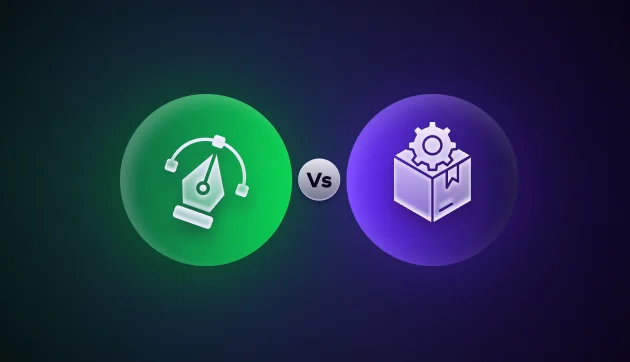



Awesome
I appreciate you sharing this valuable information. In my opinion, it’s fantastic.